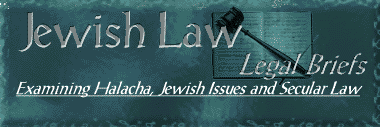

Board of Education of the Kiryas Joel Village School District v. Grimet
New York Court of Appeals
(1993)
TO UPHOLD THE DECISION BELOW, ESPECIALLY
IN THE WAKE OF THE COURT'S RECENT FREE
EXERCISE JURISPRUDENCE, WOULD LEAVE MI-
NORITY RELIGIOUS PRACTITIONERS AND
COMMUNITIES EXTREMELY VULNERABLE
Agudath Israel, like many other religious groups throughout the nation, shuddered to read the Court's words in Employment Division, Department of Human Resources of Oregon v. Smith, 494 U.S. 872, 890 (1990):
|
"Values that are protected against government interference through
enshrinement in the Bill of Rights are not thereby banished from the
political process....[T]o say that a nondiscriminatory
religious-practice exemption is permitted, or even that it is
desirable, is not to say that it is constitutionally required, and
that the
|
|
appropriate occasions for its creation can be discerned by the courts.
It may fairly be said that leaving accommodation to the political
process will place at a relative disadvantage those religious practices
that are not widely engaged in; but that unavoidable consequence of
democratic government must be preferred to a system in which each
conscience is a law unto itself or in which judges weigh the social
importance of all laws against the centrality of religious beliefs."
[Emphasis added.]
|
The background leading to the passage of Chapter 748, and indeed the substance of Chapter 748 itself, confirm the accuracy of Smith's observation about the "relative disadvantage" faced by minority religionists. Based on the traumatic experiences of the Hasidic children who did spend some time in its public school special education classes, the Monroe-Woodbury Central School District had full knowledge that its public schools were not the most appropriate environment in which to provide special education to the handicapped children of Kiryas Joel. Yet the school district continued to insist that the children come to the public schools -- even after the New York Court of Appeals rejected its legal contention
And so, put in a position where they could neither compel nor persuade the Monroe-Woodbury Central School District to accommodate their needs, the Villagers of Kiryas Joel did precisely what Smith would have encouraged Native Americans seeking accommodations of their peyote rituals to do: turn to the legislature for relief.
For all of the talk in the courts below about Chapter 748 as an "endorsement" of a particular denomination, the nature of the remedy fashioned by the legislature was surely less than ideal from the perspective of the Hasidim. It imposed on the Village the new duty of establishing its own school board; and it imposed on the school board (and the public school created by the school board) all the secular legal obligations of New York State law -- including obligations generally foreign to the Hasidic way of life. Further, it gave rise to the likely eventuality that the new Kiryas Joel Village School District would have to establish a regular non-handicapped public school for children whose non-Hasidic families would move into the Village and demand regular public schooling. Neighborhoods can change, it should be recalled, even as laws remain the same.
Justice (now Chief Justice) Rehnquist, dissenting in Thomas v. Review Board of the Indiana Employment Security Division, 450 U.S. 707 (1981), commented on the increasing "tension" between the two religion clauses of the First Amendment:
|
"[P]erhaps [the] most important cause of the tension is our overly
expansive interpretation of both Clauses. By broadly construing
both Clauses, the Court has constantly narrowed the
|
|
channel between the Scylla and Charybdis through which any state or
federal action must pass in order to survive constitutional scrutiny."
450 U.S. at 721 (Rehnquist, J., dissenting; emphasis in original).
|
In Hobbie v. Unemployment Appeals Commission of Florida, 480 U.S. 136, 144-45 (1987), the Court spoke of its longstanding recognition "that the government may (and sometimes must) accommodate religious practices and that it may do so without violating the Establishment Clause." See also, e.g., Corporation of Presiding Bishop v. Amos, 483 U.S. 327 (1987). Despite the universal recognition of this general principle, courts have expressed varying degrees of deference toward legislative efforts to accommodate the needs of religious committees, with some all too eager to find that such efforts have an impermissible primary effect of "advancing religion" or creating a "symbolic union" between church and state. See generally Choper, The Religion Clauses of the First Amendment: Reconciling the Conflict, 41 U. Pitt. L. Rev. 673 (1980); McConnell, Accommodation of Religion, 1985 Sup. Ct. Rev. 1 (1985).
Failure to permit legislative bodies ample and generous leeway under the Establishment Clause to accommodate the special needs of minority religious practitioners and communities, especially in this brave new post-Smith world of diminished constitutional protection for religious free exercise, would only hasten what Professor Stephen L. Carter has referred to as "[t]he potential transformation of the Establishment Clause from a guardian of religious liberty into a guarantor of public secularism." Carter, The Culture of Disbelief: How American Law and Politics Trivialize Religious Devotion, at 122-23 (Basic Books 1993). We share Professor Carter's view that such transformation "raises prospects at once dismal and dreadful." Id. at 123.
1 | 2 | 3 | 4 | 5 | 6 | 7 | 8

DISCLAIMER
|
|
Page 6 of 8 |
|